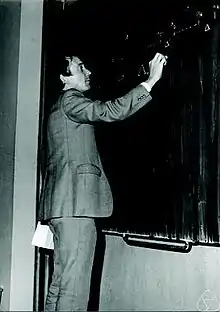Arnold Schönhage
Arnold Schönhage (born 1 December 1934 in Lockhausen, now Bad Salzuflen) is a German mathematician and computer scientist.
Professor Arnold Schönhage | |
|---|---|
 Schönhage in 1973 | |
| Born | December 1, 1934 |
| Nationality | German |
| Alma mater | University of Cologne |
| Known for | Schönhage–Strassen algorithm, Odlyzko–Schönhage algorithm, Schönhage's Storage Modification Machine (SMM) model. Splitting circle method. |
| Scientific career | |
| Fields | Mathematics |
| Institutions | University of Konstanz, University of Tübingen, Rheinische Friedrich-Wilhelms-Universität, Bonn |
| Doctoral advisor | Guido Hoheisel |
Schönhage was professor at the Rheinische Friedrich-Wilhelms-Universität, Bonn,[1] and also in Tübingen and Konstanz.[2]
Together with Volker Strassen he developed the Schönhage–Strassen algorithm for the multiplication of large numbers[1][3] that has a runtime of O(N log N log log N). For many years, this was the fastest way to multiply large integers, although Schönhage and Strassen predicted that an algorithm with a run-time of N(logN) should exist. In 2019, Joris van der Hoeven and David Harvey finally developed an algorithm with this runtime, proving that Schönhage's and Strassen's prediction had been correct.[4]
Schönhage designed and implemented together with Andreas F. W. Grotefeld and Ekkehart Vetter a multitape Turing machine, called TP, in software. The machine is programmed in TPAL, an assembler language. They implemented numerous numerical algorithms including the Schönhage–Strassen algorithm on this machine.
References
- Luerweg, Frank (December 21, 2004). "Weltrekord-Rechenmethode kommt zu späten Ehren". Informationsdienst Wissenschaft. Retrieved 2023-10-21.
- "Arnold Schönhage". The Mathematics Genealogy Project. North Dakota State University. Retrieved 2023-10-21.
- Fischer, Lars (April 11, 2019). "Mathematik: Die schnellste Art zu multiplizieren". Spektrum der Wissenschaft (in German). Retrieved 2023-10-21.
- Klarreich, Erica (2019-12-20). "Multiplication hits the speed limit". Communications of the ACM. 63 (1): 11–13. doi:10.1145/3371387. ISSN 0001-0782.